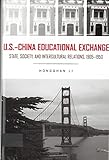U.S.- China Educational Exchange : State, Society, and Intercultural Relations, 1905-1950 / Hongshan Li.
Material type: TextPublisher: New Brunswick, NJ : Rutgers University Press, [2007]Copyright date: ©2007Description: 1 online resource (320 p.)Content type:
TextPublisher: New Brunswick, NJ : Rutgers University Press, [2007]Copyright date: ©2007Description: 1 online resource (320 p.)Content type: - 9780813541990
- 9780813543925
- 370.116/2 22
- online - DeGruyter
| Item type | Current library | Call number | URL | Status | Notes | Barcode | |
|---|---|---|---|---|---|---|---|
 eBook
eBook
|
Biblioteca "Angelicum" Pont. Univ. S.Tommaso d'Aquino Nuvola online | online - DeGruyter (Browse shelf(Opens below)) | Online access | Not for loan (Accesso limitato) | Accesso per gli utenti autorizzati / Access for authorized users | (dgr)9780813543925 |
Frontmatter -- Contents -- Acknowledgments -- Introduction: Educational Exchange and the Visible Hand -- 1 Emerging as Facilitator -- 2 Tearing Down the Barriers -- 3 Qinghua: The First Joint Experiment -- 4 From Central Administration to Party Control -- 5 Maintaining the Educational Front -- 6 From Expansion to Termination -- 7 A Historical Perspective -- Epilogue: Restoring Educational Relations with the Visible Hand -- Appendix -- Notes -- Bibliography -- Index -- About the Author
restricted access online access with authorization star
http://purl.org/coar/access_right/c_16ec
U.S.-China relations became increasingly important and complex in the twentieth century. While economic, political, and military interactions all grew over time, the most dramatic expansion took place in educational exchange, turning it into the strongest tie between the two nations. By the end of the 1940s, tens of thousands of Chinese and American students and scholars had crisscrossed the Pacific, leaving indelible marks on both societies. Although all exchange programs were terminated during the cold war, the two nations reemerged as top partners within a decade after the reestablishment of diplomatic relations. Approaching U.S.-China relations from a unique and usually overlooked perspective, Hongshan Li reveals that both the drastic expansion and complete termination of educational ties between the two nations in the first half of the twentieth century were largely the results of direct and deep intervention from the American and Chinese governments. Benefiting from government support and collaboration, educational exchange succeeded in diffusing knowledge and improving mutual understanding between the two peoples across the divide of civilizations. However, the visible hand of government also proved to be most destructive to the development of healthy intercultural relations when educational interactions were treated merely as an instrument for crisis management.
Mode of access: Internet via World Wide Web.
In English.
Description based on online resource; title from PDF title page (publisher's Web site, viewed 27. Jan 2023)


